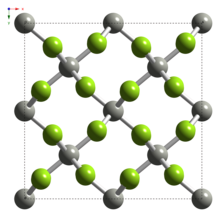
| |
| Identifiers | |
|---|---|
3D model (JSmol)
|
|
| ChemSpider | |
PubChem CID
|
|
| |
| |
| Properties | |
| F4Pd | |
| Molar mass | 182.41 g·mol−1 |
| Appearance | pink[1] or brick-red[2] crystalline solid |
| Related compounds | |
Other cations
|
Platinum(IV) fluoride |
Related compounds
|
Palladium(II) fluoride Palladium(II,IV) fluoride |
Except where otherwise noted, data are given for materials in their standard state (at 25 °C [77 °F], 100 kPa).
| |
Palladium (IV) fluoride, also known as palladium tetrafluoride, is the chemical compound of palladium and fluorine with the chemical formula PdF4. The palladium atoms in PdF4 are in the +4 oxidation state.[2][3]
Synthesis
[edit]Palladium tetrafluoride has been prepared by reacting palladium(II,IV) fluoride with fluorine gas at pressures around 7 atm and at 300 °C for several days.[1]
Reactivity
[edit]PdF4 is a strong oxidising agent and undergoes rapid hydrolysis in moist air.[1]
See also
[edit]References
[edit]- ^ a b c Rao, P. R.; Tressaud, A.; Bartlett, N. (1976). "The tetrafluorides of iridium, rhodium and palladium". J. Inorg. Nucl. Chem. 28: 23–28. doi:10.1016/0022-1902(76)80588-X.
- ^ a b Greenwood, Norman N.; Earnshaw, Alan (1997). Chemistry of the Elements (2nd ed.). Butterworth-Heinemann. pp. 1152–1153. ISBN 978-0-08-037941-8.
- ^ Housecroft, C. E.; Sharpe, A. G. (2008). Inorganic Chemistry (3rd ed.). Prentice Hall. pp. 788–789. ISBN 978-0-13-175553-6.
Well, that’s interesting to know that Psilotum nudum are known as whisk ferns. Psilotum nudum is the commoner species of the two. While the P. flaccidum is a rare species and is found in the tropical islands. Both the species are usually epiphytic in habit and grow upon tree ferns. These species may also be terrestrial and grow in humus or in the crevices of the rocks.
View the detailed Guide of Psilotum nudum: Detailed Study Of Psilotum Nudum (Whisk Fern), Classification, Anatomy, Reproduction